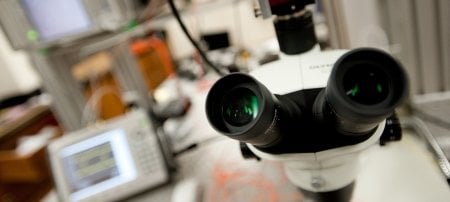Jeremy Bos is a 2016 recipient of the Young Investigator Program (YIP) through the Air Force Office of Scientific Research.
Bos, an assistant professor of electrical engineering studying atmospheric optics at Michigan Technological University, wants to help the Air Force see better. The problem is turbulence.
Twinkling stars and mirages over hot roads are examples of atmospheric turbulence we see every day; the distortion comes from the way light interacts with shifting air. Sometimes turbulence causes the image to appear blurred. Other times it can be like looking at your reflection in rippling water. Scientists and engineers describe these effects mathematically using what they call blurring functions. When every pixel in an image has the same blurring function, the distortion is said to be “isoplanatic”. In this case the image is just blurred. In the case of the rippling water, different parts of the image are distorted differently. In this case it is “anisoplanatic”
"In my work, I'm looking at the case where every single pixel in an image has a different blurring function," Bos says. Bos calls this “extreme anisoplanatism”.

Line of Sight and Lasers
With his YIP award, a highly competitive program for early career scientists and engineers through the Air Force, Bos is piecing together images affected by anisoplanatism over long distances.
"The objective is to see better and farther," Bos says, adding that imaging isn’t the only application; his work will also improve long-range optical communication systems. Yet another application "… defending against threats using laser light."
Whether as a shield around an aircraft or a Star Wars-style laser beam, the technology comes down to manipulating light.
"But in order to do these things, you have to account for the atmosphere," Bos says. "and when you’re dealing with anisoplanatism —that's a wicked, hard problem."
Light and Air
The problem is a classic signal-to-noise issue. If the signal is an accurate image, then the distortion caused by turbulence is noise. With enough signal, the image can be recreated: each tipped or tilted pixel in a distorted image can be put back. Bos likens his work to the inverse of the technology used to stream videos online, "Video encoding technology tries to predict how portions of an image frame change from one frame to another. In my work, I look at many distorted images of the same scene and try and match each pixel to its true location.”
He adds that clearing up the noise from turbulence will do more than resolve two-dimensional images. It also provides information about the atmosphere as a three-dimensional space.
"If I can characterize the atmosphere tomographically—like doctors do with CT scans—then I can use other techniques to back out the turbulence,” he explains. With this information, Bos says he can "send laser beams farther and data faster."
Atmospheric Optics
“Receiving the YIP is a great honor and underscores the importance of basic imaging research in the area of extreme anisoplanatism,” Bos says. Daniel Fuhrmann, chair of the Department of Electrical and Computer Engineering, says he's delighted but not surprised about Bos' award.
"Jeremy's contributions to the department are key to our long-term strategies for achieving success in research and teaching," Fuhrmann says. "He is already making his presence known at Michigan Tech in significant ways, in both applied optics and robotics."
Mike Roggeman, a professor of electrical engineering at Michigan Tech and Bos' mentor in optical engineering, agrees that Bos' work studying turbulence is crucial.
"The optical effects of ever-present atmospheric turbulence limit the performance of imaging and laser beam projection systems that must work in its presence," Roggeman says. "Even after decades of study, there are still unanswered questions about the underlying statistical nature of the turbulence."
Bos' work in mitigating extreme anisoplanatism will help clear the air.
Michigan Technological University is an R1 public research university founded in 1885 in Houghton, and is home to nearly 7,500 students from more than 60 countries around the world. Consistently ranked among the best universities in the country for return on investment, Michigan's flagship technological university offers more than 185 undergraduate and graduate degree programs in science and technology, engineering, computing, forestry, business, health professions, humanities, mathematics, social sciences, and the arts. The rural campus is situated just miles from Lake Superior in Michigan's Upper Peninsula, offering year-round opportunities for outdoor adventure.






Comments